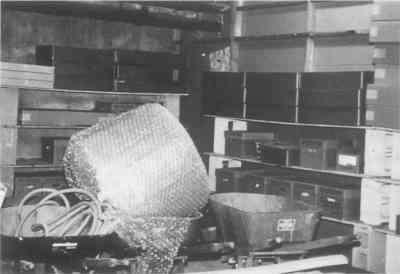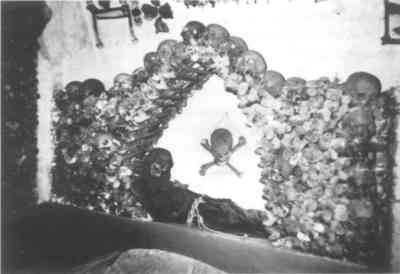THE ETHICAL DILEMMA FACING CONSERVATION: CARE AND TREATMENT OF HUMAN SKELETAL REMAINS AND MORTUARY OBJECTSGAYS S. McGOWAN, & CHERYL J. LaROCHE
6 CONSERVATION AND SCIENTIFIC CONCERNS6.1 PROPER STORAGEThe proper storage and treatment of human remains serve the interests of both an engaged descendant community and the scientific community. For instance, New York City's descendant community was outraged that skeletal material from the African Burial Ground was wrapped in newspaper and stored in cardboard boxes in a closet. (Literally, there were skeletons in a closet.) The introduction of acid-free paper, appropriate storage cabinets, and environmental controls at least partially allayed these concerns and communicated a degree of respect that the remains deserved (Yamin 1995), in addition to conforming to sound conservation practices. For conservation professionals, passive or nonintervention conservation measures are the preferred treatment strategies for stabilization (AIC 1995). Unfortunately, the lack of adequate environmental controls in many institutions hastens degradation. Too often, the level of storage reserved for human remains is represented by substandard conditions (fig. 5). As an advocate for skeletal materials, the conservator must provide a certain level of monitoring, since often there is little management for the preservation of the materials and a disinterested third party, such as the state or contracting entity, may control the collection.
6.2 CHEMICAL ANALYSISFor the archaeology, conservation, and physical anthropology professions, human remains have extraordinary analytic potential and scientific value through a variety of assessments and tests such as deoxyribonucleic acid (DNA), carbon-14 dating, and trace element and stable isotope analysis. These tests result in the generation of data pertaining to genetic markers; dating; bone histology and pathology; foodways; mortality; dietary, nutritional, and environmental stresses of skeletal populations; and identification of blood proteins. Often, these diseases and stresses manifest as unique pathological lesions or anomalies on the bone. Osteomyelitis, periosteal manifestations of localized and systemic infections, and tubercular lesions, for example, are among the external indicators of these diseases and stresses. Often, their presence and effect on the bone are subtle and tenuously preserved and can be easily overlooked, mishandled, or damaged during excavation, conservation, and subsequent study. Although currently the ability exists to conduct a wide range of sophisticated archaeometric and bioanthropological tests on bone, it is not always prudent or ethical to jeopardize the physical characteristics of bone for potential future analysis based on elements that have not necessarily survived in the sample. Moreover, analysis of the physical properties of bone is not exclusive to anthropology and may be applicable wherever human bone has been curated or preserved. Ongoing scientific advances have allowed biochemical and immunological data to be extracted from diverse materials such as mummies, relics, and osteological collections (fig. 6). Unfortunately, the chemical analytical potential is often tenuous at best, and to serve up the physical aspects of the skeletal material as a sacrificial offering without careful consideration of both the spiritual concerns and the scientific consequences of sectioning bone for sampling and analysis can be naive and unconscionable.
Earlier in this century, Howard Carter and his team demonstrated little regard for human skeletal material as the bones of Tutankhamen were shattered and fractured in the pursuit and extrication of treasure. Similarly, modern scientists can be seen as the new treasure seekers, cutting human bone in the quest for scientific 6.3 CONSERVATION PRECEPTSA precept within our discipline requires that when conducting analytical testing and sampling, conservators be responsive to artistic intent and to the integrity of the object. Unfortunately, a limited perspective toward human skeletal material often clouds our ability to perceive the importance of human bone in comparison to fine and decorative art. Similarly, this sensibility toward skeletal material is frequently not realized within the anthropological profession, where the attitude of “acceptable level of damage” has been expressed (Peer Review Committee 1992). Analytical sampling and treatment strategies need to be particularly sensitive to the physical and metaphysical properties of human bone. Furthermore, the hygroscopic nature of bone renders it highly reactive to fluctuating RH levels and other environmental conditions. The resulting warpage, cracking and distortion, spalling, and abrasions of the cortical layer can obscure or invalidate the analytical potential of the bone and may necessitate intervention and/or treatment. Bone is also susceptible to attack by pollutants and other environmental contaminants. Infestation of biological agents and pests forces the conservator to postulate the efficacy of biocides and pest management systems that may inevitably alter bone chemistry. Additionally, human remains are curated and treated for a variety of purposes that will often dictate treatment strategies. Archaeological bone may simply need consolidation to facilitate excavation and subsequent handling or display (Koob 1992). Archaeologists and conservators have devised techniques and materials using polymers to give structural support to deteriorating, fragile bone (Johnson 1994). Consolidants and adhesives selected by archaeologists for strength and visual properties, such as Butvar (Kres and Lovell 1995), may be inappropriate if chemical testing is anticipated (Johnson 1994) or may have properties that conservators find objectionable (Johansson 1987). Even the use of detergents can contaminate bone, making it useless for various chemical and analytical investigations (Sease 1994). The morphological structure of the bone may need to be preserved. Fragmented bones often require reconstruction or consolidation before viable anthropometric analysis, one of the cornerstones of physical anthropology, can occur. The properties of the adhesives and consolidants used for these purposes should be clearly understood. As we know from our work in other areas of conservation, certain adhesives expand during the curing process or are subject to other dimensional changes. These changes can alter precise anthropometric results. Our profession advocates nonintervention whenever possible. For human skeletal materials this policy would ensure the most untainted data and would most likely be less offensive to affected descendant communities and concerned groups. Frequently, however, compromises pertaining to chemical analysis must be made between the preservation of fragile, friable physical attributes and nonintervention strategies (Johansson 1987). The nonintervention approach must be viewed partially as a response to the realization that often reversibility is a myth, “illustrating the gap in the field of conservation between practice and theory” (Appelbaum 1987, 69). The “principle of reversibility” as discussed by Appelbaum (1987) and Horie (1987) is more appropriate for objects and artistic works than for anatomical collections that have different considerations and criteria for reversibility. As Horie (1987, 6) has observed, once a polymer has been applied to porous material, such as bone, “it may be impossible to remove more than a small proportion of the same polymer…. Techniques for examination are increasingly sensitive and require uncontaminated samples. It is unlikely Bone is a discrete material composed of organic and inorganic material with a hard, impervious exterior and a permeable, porous, and spongy interior (Johansson 1987). It is the mineral component that contains many of the relevant chemical elements (Crist 1995). Much of the data to be retrieved rely on the inherent nature of pristine physical condition. Realistically, many times we are forced into situations where the attempt to mitigate the further degradation of the materials requires difficult-to-reverse stabilization treatment (Appelbaum 1987). Invasive treatments may also be required to facilitate excavation or to enhance data retrieval, necessitating a trade-off between nonintervention and the physical needs of the object. 6.4 CODE OF ETHICSPursuant to the language contained in the AIC Code of Ethics (1995), the role of the conservator is to act as an advocate for proper care of cultural property that may be of artistic, historical, scientific, religious, or social significance. While some archaeologists and anthropologists have argued that human remains are outside the purview of the conservation profession as defined by the Code of Ethics, archaeological conservators are nevertheless concerned with these materials (Pye and Cronyn 1987; Peer Review Committee 1992; Koob 1992; Johnson 1994). Within that capacity, we should present our concerns to allied professions to prevent mishandling or reliance upon antiquated methods (Johnson 1994). Bones continue to be wrapped in newspaper, adhered or consolidated with materials such as Butvar (Kres and Lovell 1995), shellac, Duco Cement, Elmer's Glue, hot glue, or polystyrene without understanding the ramifications of these applications. Johnson (1994, 223) reports that “the oral history of bone preservation includes stories about the use of materials such as plastic tent windows dissolved in acetone and acrylic floor finish, techniques not often described in published accounts.” Although further research into conservation and treatment of human remains is necessary, anthropological professionals should be kept abreast of our continued abilities to assist them in responsible technical support. Conversely, we must remain aware of the continuing needs of their profession and of the ways adhesives, testing, and handling techniques may affect their ability to extract data from the materials. Proper handling and an in-depth understanding of the chemical reactions and properties of coating materials are critical to successful extraction of DNA or carbon-14 dating. Adhesives and consolidants chosen for properties that provide immediate solutions to a variety of archaeological problems may prove inappropriate for long-term research considerations. Our expertise is understanding the material (Pye and Cronyn 1987): how it will react not only to the environment but also how it will respond to the methods and materials used in preservation or stabilization (Johnson 1994). Knowing the working properties and long-term aging properties of one brand of adhesive is not a predictor of these properties in another brand (Johnson 1994). The understanding of these complexities and the symbiotic reactions of associated materials is what conservation contributes to the interdisciplinary dialogue. This unique understanding of materials is often misinterpreted by other related professionals who may feel that conservators are outside their professional bounds (Pye and Cronyn 1987; Peer Review Committee 1992; Johnson 1994), particularly since the Code of Ethics pertains to works of art, historic materials, and cultural properties (AIC 1995). This attitude can lead to misunderstanding and suspicion, which are counterproductive to the interdisciplinary process. To date, conservators have not The solutions to the ethical dilemmas associated with the treatment and handling of human remains are not linear. This complex tangle of issues demands an interdisciplinary approach combined with awareness of spiritual and philosophical belief systems. Ideally, the Code of Ethics should be responsive to the multivariant concerns by recognizing human remains as a discrete material requiring unique considerations that are separate and apart from any other materials we treat. The Commentary section, as a valuable addition to the Code of Ethics, could delineate a number of conventions necessary for the proper handling and treatment of remains. The sacred aspects of skeletal materials should also be taken into account. |

